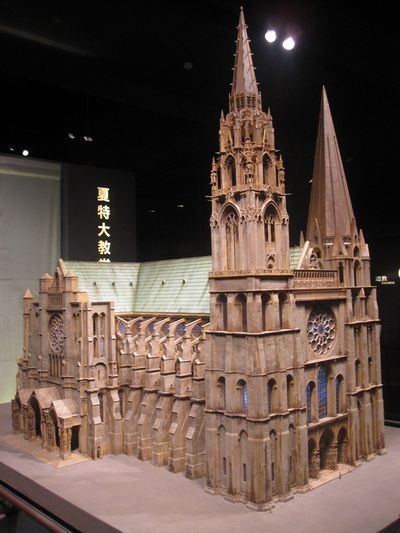Chartres Cathedral
The front of the cathedral at Chartres.
Chartres Cathedral (Cathédrale Notre-Dame de Chartres) is a great cathedral in Chartres, France. It was built between 1193 and 1250 in the Gothic architectural style over the burned ruins of an ongoing project to modernize a previous wood-roofed Romanesque church.
The church was the center of Mariolatry in France as it housed a gift acquired from Constantinople by Charles the Bald that was known to be the tunic worn by Virgin Mary at Jesus's nativity. The new facade and the Romanesque choir survived the fire, which befell on the surrounding large part of the town on June 10, 1194, and along with them the tunic, which was preserved in the crypt below the choir. The priests explained this to the townspeople as Mary's wish to be reinstalled in even greater magnificence, and the constructions started anew right away amidst the rubbles to fulfill her wish.
The limit placed on the nave's length by the fault that occurs to the east was made up for in height. In its transformation to the gothic style, the new nave was more vertically spacious and faced larger ends a larger facade a large rose window above the three lancets of the previous facade a greater facade
, at the twin-twer facade an outer ambulatory was built which reduced the depth of the Romanesque radiating chapels, and . in the style of Saint Denis
And by 1220 Our Lady of Chartres was ready for consecration.
The new nave had to remain relatively short. Since the site is intersected by a fault to the east, the choir could not push outward. Instead, an outer ambulatory in the manner of St.-Denis reduced the depth of the Romanesque radiating chapels, making them less obtrusive, more Gothic. The western limit was fixed by the facade with the Royal Portals. But what the new church could not excel in length, it made up for in height. To account for the disparity in height between the towering nave and the facade of an older day, the architect installed a large rose window above the three lancets already there. (Fig. "14.15) This, too, was an invention of Suger for his facade at St.MEASURING

A detailed model of the Chartres Cathedral at the Museum of World Religion in Taipei.